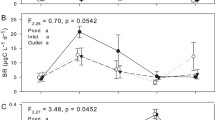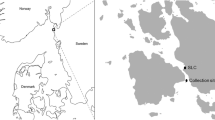Abstract
Dissolved organic matter (DOM) input is a key factor for freshwater ecology, since it regulates many aspects of aquatic ecosystem metabolism. Aquatic and terrestrial animals that inhabit or frequent aquatic environments also influence the DOM inputs via their faeces, supplying nutrients such as carbon (C), nitrogen (N), and phosphorus (P). Here, we analyse the response of a bacterial community in the newly formed proglacial Lake Ventisquero Negro (Mount Tronador) to the addition of dissolved nutrients from faeces leachate of the native goose (Chloephaga poliocephala Sclater, 1857; locally called “cauquén”) and the European hare (Lepus europaeus Pallas, 1778). A laboratory incubation experiment was carried out with unenriched lake water and lake water enriched with leachate from hare or goose faeces. The results showed that faeces and leachates of geese were richer in nutrients than those of hares. Spectrofluorometric analysis of the DOM also showed differences between the two sources. Nutrient enrichment positively affected bacterial respiration and short-term carbon consumption. Thus, the faeces of these two animals may play an important ecological role by supplying allochthonous DOM and nutrients to this new ecosystem.







Similar content being viewed by others
References
Adrian, R., C. M. O’Reilly, H. Zagarese, S. B. Baines, D. O. Hessen, W. Keller, D. M. Livingstone, R. Sommaruga, D. Straile & E. Van Donk, 2009. Lakes as sentinels of climate change. Limnology and Oceanography 54(6part2): 2283–2297.
Anesio, A. M., B. Sattler, C. Foreman, J. Telling, A. Hodson, M. Tranter & R. Psenner, 2010. Carbon fluxes through bacterial communities on glacier surfaces. Annals of Glaciology 51(56): 32–40.
APHA, 2005. Methods for the Examination of Water and Wastewater. American Public Health Association, American Water Works Association, Water Environment Federation, Washington, DC.
Bastidas Navarro, M., N. Martyniuk, E. Balseiro & B. Modenutti, 2018. Effect of glacial lake outburst floods on the light climate in an Andean Patagonian lake: implications for planktonic phototrophs. Hydrobiologia 816(1): 39–48.
Bastidas Navarro, M., V. D. Villanueva & B. Modenutti, 2019. High phosphorus content in leachates of the austral beech Nothofagus pumilio stimulates bacterioplankton C-consumption. Freshwater Science 38(3): 435–447.
Batanero, G. L., E. León-Palmero, L. Li, A. J. Green, M. Rendón-Martos, C. A. Suttle & I. Reche, 2017. Flamingos and drought as drivers of nutrients and microbial dynamics in a saline lake. Scientific Reports 7(1): 12173.
Bertoni, R., C. Callieri, E. Balseiro & B. Modenutti, 2008. Susceptibility of bacterioplankton to nutrient enrichment of oligotrophic and ultraoligotrophic lake waters. Journal of Limnology 67(2): 120–127.
Bradley, J. A., J. S. Singarayer & A. M. Anesio, 2014. Microbial community dynamics in the forefield of glaciers. Proceedings of the Royal Society B: Biological Sciences 281(1795): 20140882.
Brown, T. L., H. E. LeMay & R. Wilson, 1988. Chemistry: The central science. Prentice Hall, Englewood Cliffs, NJ.
Bump, J. K., B. G. Bergman, A. J. Schrank, A. M. Marcarelli, E. S. Kane, A. C. Risch & M. Schütz, 2017. Nutrient release from moose bioturbation in aquatic ecosystems. Oikos 126(3): 389–397.
Chiou, C. T., D. E. Kile, T. I. Brinton, R. L. Malcolm, J. A. Leenheer & P. MacCarthy, 1987. A comparison of water solubility enhancements of organic solutes by aquatic humic materials and commercial humic acids. Environmental Science & Technology 21(12): 1231–1234.
Comte, J., A. I. Culley, C. Lovejoy & W. F. Vincent, 2018. Microbial connectivity and sorting in a High Arctic watershed. The ISME Journal 12(12): 2988–3000.
Dessborn, L., R. Hessel & J. Elmberg, 2016. Geese as vectors of nitrogen and phosphorus to freshwater systems. Inland Waters 6(1): 111–122.
Domínguez, N. Y., 2018. Análisis comparativo de la utilización del hábitat y de la dieta por parte del cauquen común (Chloephaga picta) entre un área principal de cría y un área principal de invernada durante el mismo año. Bachelor Thesis from Universidad Nacional del Centro de la Provincia de Buenos Aires.
Fellman, J., D. D’Amore, E. Hood & R. Boone, 2008. Fluorescence characteristics and biodegradability of dissolved organic matter in forest and wetland soils from coastal temperate watersheds in southeast Alaska. Biogeochemistry 88(2): 169–184.
Fisher, S. G. & G. E. Likens, 1973. Energy flow in Bear Brook, New Hampshire: an integrative approach to stream ecosystem metabolism. Ecological monographs 43(4): 421–439.
Franzetti, A., V. Tatangelo, I. Gandolfi, V. Bertolini, G. Bestetti, G. Diolaiuti, C. D’agata, C. Mihalcea, C. Smiraglia & R. Ambrosini, 2013. Bacterial community structure on two alpine debris-covered glaciers and biogeography of Polaromonas phylotypes. The ISME Journal 7(8): 1483.
Guillemette, F. & P. A. del Giorgio, 2011. Reconstructing the various facets of dissolved organic carbon bioavailability in freshwater ecosystems. Limnology and Oceanography 56(2): 734–748.
Hahn, S., S. Bauer & M. Klaassen, 2008. Quantification of allochthonous nutrient input into freshwater bodies by herbivorous waterbirds. Freshwater Biology 53(1): 181–193.
Hodson, A., A. M. Anesio, M. Tranter, A. Fountain, M. Osborn, J. Priscu, J. Laybourn-Parry & B. Sattler, 2008. Glacial ecosystems. Ecological Monographs 78(1): 41–67.
Hood, E., J. Fellman, R. G. Spencer, P. J. Hernes, R. Edwards, D. D’Amore & D. Scott, 2009. Glaciers as a source of ancient and labile organic matter to the marine environment. Nature 462(7276): 1044.
IPCC, 2014. Climate Change 2014: Synthesis Report. Contribution of Working Groups I, II and III to the Fifth Assessment Report of the Intergovernmental Panel on Climate Change. R.K.P.a.L.a.M.E. Core Writing Team, p. 151 pp. IPCC.
Jensen, T. C., B. Walseng, D. O. Hessen, I. Dimante-Deimantovica, A. A. Novichkova, E. S. Chertoprud, M. V. Chertoprud, E. G. Sakharova, A. V. Krylov & D. Frisch, 2019. Changes in trophic state and aquatic communities in high Arctic ponds in response to increasing goose populations. Freshwater Biology 64(7): 1241–1254.
Kominoski, J. S. & A. D. Rosemond, 2011. Conservation from the bottom up: forecasting effects of global change on dynamics of organic matter and management needs for river networks. Freshwater Science 31(1): 51–68.
Kuijper, D., S. Van Wieren & J. Bakker, 2004. Digestive strategies in two sympatrically occurring lagomorphs. Journal of Zoology 264(2): 171–178.
Lapierre, J.-F. & P. del Giorgio, 2014. Partial coupling and differential regulation of biologically and photochemically labile dissolved organic carbon across boreal aquatic networks. Biogeosciences 11(20): 5969–5985.
Manny, B. A., W. Johnson & R. Wetzel, 1994. Nutrient Additions by Waterfowl to Lakes and Reservoirs: Predicting Their Effects on Productivity and Water Quality Aquatic Birds in the Trophic Web of Lakes. Springer, Dordrecht: 121–132.
Margesin, R. & V. Miteva, 2011. Diversity and ecology of psychrophilic microorganisms. Research in Microbiology 162(3): 346–361.
Masiokas, M. H., R. Villalba, B. H. Luckman, M. E. Lascano, S. Delgado & P. Stepanek, 2008. 20th-century glacier recession and regional hydroclimatic changes in northwestern Patagonia. Global and Planetary Change 60(1): 85–100.
McCallister, S. L. & P. A. Del Giorgio, 2008. Direct measurement of the d13C signature of carbon respired by bacteria in lakes: linkages to potential carbon sources, ecosystem baseline metabolism, and CO2 fluxes. Limnology and Oceanography 53(4): 1204.
Meyers, P. A. & E. Lallier-Vergès, 1999. Lacustrine sedimentary organic matter records of Late Quaternary paleoclimates. Journal of Paleolimnology 21(3): 345–372.
Milly, P. C., K. A. Dunne & A. V. Vecchia, 2005. Global pattern of trends in streamflow and water availability in a changing climate. Nature 438(7066): 347–350.
Mindl, B., A. M. Anesio, K. Meirer, A. J. Hodson, J. Laybourn-Parry, R. Sommaruga & B. Sattler, 2007. Factors influencing bacterial dynamics along a transect from supraglacial runoff to proglacial lakes of a high Arctic glacieri. FEMS Microbiology Ecology 59(2): 307–317.
Mladenov, N., R. Sommaruga, R. Morales-Baquero, I. Laurion, L. Camarero, M. C. Dieguez, A. Camacho, A. Delgado, O. Torres & Z. Chen, 2011. Dust inputs and bacteria influence dissolved organic matter in clear alpine lakes. Nature Communications 2: 405.
Modenutti, B., M. Bastidas Navarro, N. Martyniuk & E. Balseiro, 2018. Melting of clean and debris-rich ice differentially affect nutrients, dissolved organic matter and bacteria respiration in the early ontogeny of the newly formed proglacial Ventisquero Negro Lake (Patagonia Argentina). Freshwater Biology 63(11): 1341–1351.
Murphy, K. R., C. A. Stedmon, D. Graeber & R. Bro, 2013. Fluorescence spectroscopy and multi-way techniques. PARAFAC. Analytical Methods 5(23): 6557–6566.
Pehrson, Å., 1983. Caecotrophy in caged mountain hares (Lepus timidus). Journal of Zoology 199(4): 563–574.
Piccolo, A. & P. Conte, 2000. Molecular size of humic substances. Supramolecular associations versus macromolecular polymers. Advances in Environmental Research 3(4): 508–521.
Porter, K. G. & Y. S. Feig, 1980. The use of DAPI for identifying and counting aquatic microflora. Limnology and Oceanography 25(5): 943–948.
Portnoy, J., 1990. Gull contributions of phosphorus and nitrogen to a Cape Cod kettle pond. Hydrobiologia 202(1): 61–69.
Roman, J. & J. J. McCarthy, 2010. The whale pump: marine mammals enhance primary productivity in a coastal basin. PLoS ONE 5(10): e13255.
Rose, K. C., C. E. Williamson, C. E. Kissman & J. E. Saros, 2015. Does allochthony in lakes change across an elevation gradient? Ecology 96(12): 3281–3291.
Rosemond, A. D., P. J. Mulholland & J. W. Elwood, 1993. Top-down and bottom-up control of stream periphyton: effects of nutrients and herbivores. Ecology 74(4): 1264–1280.
Skadhauge, E., 2012. Osmoregulation in Birds, Vol. 12. Springer, New York.
Slemmons, K. E., J. E. Saros & K. Simon, 2013. The influence of glacial meltwater on alpine aquatic ecosystems: a review. Environmental Science: Processes & Impacts 15(10): 1794–1806.
Sommaruga, R., 2001. The role of solar UV radiation in the ecology of alpine lakes. Journal of Photochemistry and Photobiology B: Biology 62(1–2): 35–42.
Sommaruga, R., 2015. When glaciers and ice sheets melt: consequences for planktonic organisms. Journal of Plankton Research 37(3): 509–518.
Stedmon, C. A. & R. Bro, 2008. Characterizing dissolved organic matter fluorescence with parallel factor analysis: a tutorial. Limnology and Oceanography Methods 6: 572–579.
Stedmon, C. A. & S. Markager, 2005. Tracing the production and degradation of autochthonous fractions of dissolved organic matter by fluorescence analysis. Limnology and Oceanography 50(5): 1415.
Subalusky, A. L., C. L. Dutton, E. J. Rosi-Marshall & D. M. Post, 2015. The hippopotamus conveyor belt: vectors of carbon and nutrients from terrestrial grasslands to aquatic systems in sub-Saharan Africa. Freshwater Biology 60(3): 512–525.
Turpin-Jelfs, T., K. Michaelides, J. J. Blacker, L. G. Benning, J. M. Williams & A. M. Anesio, 2018. Distribution of soil nitrogen and nitrogenase activity in the forefield of a High Arctic receding glacier. Annals of Glaciology 59(77): 87–94.
Van de Waal, D. B., A. M. Verschoor, J. M. Verspagen, E. van Donk & J. Huisman, 2010. Climate-driven changes in the ecological stoichiometry of aquatic ecosystems. Frontiers in Ecology and the Environment 8(3): 145–152.
Villalba, R., J. A. Boninsegna, T. T. Veblen, A. Schmelter & S. Rubulis, 1997. Recent Trends in Tree-Ring Records from High Elevation Sites in the Andes of Northern Patagonia Climatic Change at High Elevation Sites. Springer, New York: 193–222.
Wetzel, R. G., 2001. Limnology: Lake and River Ecosystems. Gulf Professional Publishing, Oxford.
Wojcik, R., J. Donhauser, B. Frey, S. Holm, A. Holland, A. M. Anesio, D. A. Pearce, L. Malard, D. Wagner & L. G. Benning, 2018. Linkages between geochemistry and microbiology in a proglacial terrain in the High Arctic. Annals of Glaciology 59(77): 95–110.
Acknowledgements
This work was supported by FONCYT (PICT 2015-0418, PICT 2015-2138). EV is the holder of a CONICET Fellowship, and MBN and BM are CONICET researchers. We thank Ariel Mayoral for help during sampling. This work was carried out within the framework of the Argentinian National Inter-University Council (CIN).
Author information
Authors and Affiliations
Corresponding author
Additional information
Handling editor: Chris Joyce
Publisher's Note
Springer Nature remains neutral with regard to jurisdictional claims in published maps and institutional affiliations.
Electronic supplementary material
Below is the link to the electronic supplementary material.
Rights and permissions
About this article
Cite this article
Vega, E.N., Bastidas Navarro, M. & Modenutti, B. Goose and hare faeces as a source of nutrients and dissolved organic matter for bacterial communities in the newly formed proglacial lake Ventisquero Negro (Patagonia, Argentina). Hydrobiologia 847, 1479–1489 (2020). https://doi.org/10.1007/s10750-020-04202-4
Received:
Revised:
Accepted:
Published:
Issue Date:
DOI: https://doi.org/10.1007/s10750-020-04202-4




